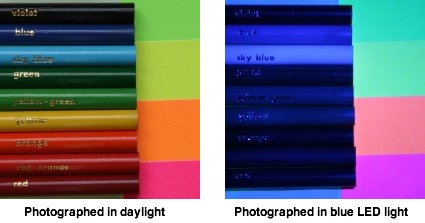Blue LED Fluorescence
Blue light-emitting diodes (LEDs) cause
fluorescence in common materials. Jim found this surprising; maybe you'll find
it interesting.
Fluorescence is a phenomenon in which a material
absorbs light of one wavelength, and emits light of a longer wavelength. It is
often demonstrated using ultraviolet light, which has shorter wavelengths than
visible light. Ultraviolet light causes many materials to emit visible light of
various colors.
Fluorescent dyes and pigments are used to make many objects with bright colors (often referred to as day-glo colors, though the term is technically a trademark). I had long assumed that these materials relied on the presence of ambient ultraviolet light, but a few months ago, while using a small blue-LED flashlight, I was surprised to see a pen glowing bright pink in its beam.
I soon found that other blue LEDs I tried were also capable of making common fluorescent materials give off colors other than blue. The effect can be dramatic. If you shine a blue LED around a dark room, the scene is generally monochromatic, with objects ranging in apparent color from light blue to black. But here and there you may see something green or yellow or pink standing in stark contrast to its blue surroundings.
The photos below show the effect. Each shows a set of non-fluorescent colored pencils on the left, and parts of four fluorescent index cards on the right. The first photo was taken in daylight, and the normal colors of both the pencils and the cards can be seen (yes, the violet pencil on top did actually look nearly black, and the red pencil on the bottom was a rather dull red).

The second photo was taken in the light of a blue LED. The non-fluorescent pencils show very little color other than blue. The fluorescent cards look somewhat bluer than in daylight, but they clearly show varying degrees of green, orange and red hues as well. (To the eye, the cards seem much closer to their daylight colors than in this photo, but this may be due to the visual system partially compensating for the blue light.)
In fact, I've learned that this fluorescence is used to make white LEDs. LEDs generally emit a rather narrow range of wavelengths (which typically gives them very intense color). It would be possible to create white-looking light by combining blue, green and red LEDs, but most white LEDs are made from a blue LED combined with a fluorescent material that emits a range of wavelengths centered in the yellow part of the spectrum. The result appears white, but is often weak in red and green wavelengths, so colors can look unnatural in this light.
Fluorescent dyes and pigments are used to make many objects with bright colors (often referred to as day-glo colors, though the term is technically a trademark). I had long assumed that these materials relied on the presence of ambient ultraviolet light, but a few months ago, while using a small blue-LED flashlight, I was surprised to see a pen glowing bright pink in its beam.
I soon found that other blue LEDs I tried were also capable of making common fluorescent materials give off colors other than blue. The effect can be dramatic. If you shine a blue LED around a dark room, the scene is generally monochromatic, with objects ranging in apparent color from light blue to black. But here and there you may see something green or yellow or pink standing in stark contrast to its blue surroundings.
The photos below show the effect. Each shows a set of non-fluorescent colored pencils on the left, and parts of four fluorescent index cards on the right. The first photo was taken in daylight, and the normal colors of both the pencils and the cards can be seen (yes, the violet pencil on top did actually look nearly black, and the red pencil on the bottom was a rather dull red).

The second photo was taken in the light of a blue LED. The non-fluorescent pencils show very little color other than blue. The fluorescent cards look somewhat bluer than in daylight, but they clearly show varying degrees of green, orange and red hues as well. (To the eye, the cards seem much closer to their daylight colors than in this photo, but this may be due to the visual system partially compensating for the blue light.)
In fact, I've learned that this fluorescence is used to make white LEDs. LEDs generally emit a rather narrow range of wavelengths (which typically gives them very intense color). It would be possible to create white-looking light by combining blue, green and red LEDs, but most white LEDs are made from a blue LED combined with a fluorescent material that emits a range of wavelengths centered in the yellow part of the spectrum. The result appears white, but is often weak in red and green wavelengths, so colors can look unnatural in this light.
Quick Links
Calendar
| Sun | Mon | Tue | Wed | Thu | Fri | Sat |
Categories
Archives
XML/RSS Feed
Statistics
Total entries in this blog:
Total entries in this category:
Published On: Feb 25, 2007 07:18 PM
Total entries in this category:
Published On: Feb 25, 2007 07:18 PM